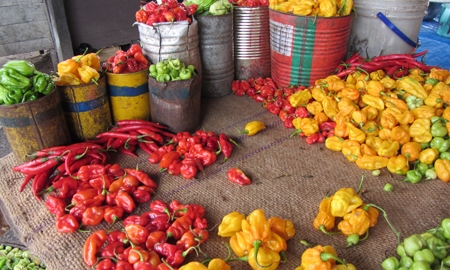
Agriculture accounts for almost half of Ghana’s GDP and generates most of its foreign exchange. Over half the workforce earn their living from the land, mostly as low-income smallholder farmers.
The aim of government policy is to create a modernised agricultural sector. If it succeeds it could transform the economy, ensuring food security, creating jobs and reducing poverty.
Like most sub-Sarahan countries, Ghana relies on food imports, buying in wheat, rice, poultry, beef and sugar. The bill is around one billion dollars every year. It leaves the country vulnerable to rising commodity prices, and unable to sustain a stable currency and maintain a reasonable level of foreign reserves.
Not surprisingly, the government wants to turn Ghana from a net importer of food to a net exporter. Kwesi Ahwoi, Minister of Food and Agriculture, says modernisation and commercialisation of agriculture has the potential to transform Ghana into the breadbasket of West Africa.
Ranging from dry savannah to wet forest, Ghana’s various climatic zones, provide the conditions for growing a variety of crops. Cocoa is the most important economically. It is the country’s largest export earner after gold, and more than 3 million Ghanaians are involved in its cultivation.
Other crops include yams, grains, cocoa, oil palms, and kola nuts, as well as timber.
What holds the sector back is that approximately 85 per cent of the country’s agricultural landholders are small-scale subsistence farmers using traditional methods and hand tools, such as cutlasses and the hoes.
Mr Ahwoi says: “For the country to be able to feed her people and liberate ourselves from abject poverty, small-holder farmers need to put an end to subsistence farming and embrace modern farming with improved seeds, irrigation facilities and also have access to ready markets, storage and enough technology to prevent post harvest loses.”
Mechanization and the introduction of large-scale commercial farming are the obvious ways forward, and various strategies are being put in place to increase crop yields on land already under cultivation and to expand into new areas. Improving access to markets is also vital – ways have to be found to enable farmers to sell what they grow.
Between 2009 and 2011 the government purchased 140 new rice combine harvesters, 25 new maize harvesters, and 350 additional grain-cocoon storage facilities. The number of tractor mechanization centres has been increased from 12 in 2008 to 77.
The fertilizer subsidy was increased from the 43,176 metric tons in 2008 at the cost of $12 million to 176,000 metric tons in 2011 at the cost of $45 million, and farmers are being supplied with improved seeds and planting materials.
Through the Ghana Cocoa Board (Cocobod), the government is launching a 6-year cocoa-replanting programme, and there is a drive to substantially increase rice production. Increasing emphasis is being placed on non-traditional exports, such as such as fresh fruits and vegetables, which it is estimated could be earning $5 billion by 2015.
There are moves to link smallholders with commercial businesses through, for instance, contract farming and out-grower schemes. Agro-processing is being developed – in cocoa, for example – so that finished products can be exported rather than raw produce.
Agriculture in Ghana is largely rain-fed, but the weather can be unkind. Implementation of a master plan for irrigation development is expected to start this year. This includes the first phase of Accra Plains Irrigation Project, covering an area of about 11,000 hectares.
Fifty small irrigation dams have been rehabilitated in the three northern regions, and nine irrigation schemes have been completed in the Greater Accra, Volta, Ashanti and Brong Ahafo Regions. The Millennium Development Authority has been constructing the Kpong-left bank and the Bontanga and Golinga irrigation schemes to put more areas under irrigation.
0 COMMENTS